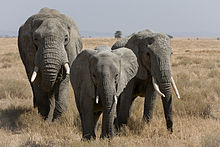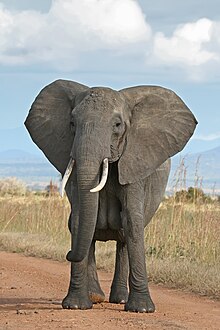Fossil members of
Loxodonta have only been found in
Africa, where they developed in the middle
Pliocene.
[edit]Description
The African elephant is the largest living terrestrial animal. Its thickset body rests on stocky legs and it has a concave back.
[5] Its large ears enable heat loss.
[6] Its upper lip and nose forms a trunk. The trunk acts as a fifth limb, a sound amplifier and an important method of touch. The African elephant's trunk ends in two opposing lips,
[7] whereas the
Asian elephant trunk ends in a single lip.
[7] African elephants are bigger than Asian elephants. Males stand 3.2–4.0 m (10–13 ft) tall at the shoulder and weigh 4,700–6,048 kg (10,000–13,330 lb), while females stand 2.2–2.6 m (7.2–8.5 ft) tall and weigh 2,160–3,232 kg (4,800–7,130 lb).
[8]The largest individual recorded stood four metres to the shoulders and weighed ten tonnes.
[5]
A male African bush elephant in
NamibiaElephants have four molars; each weighs about 5 kg (11 lb) and measures about 30 cm (12 in) long. As the front pair wears down and drops out in pieces, the back pair shifts forward, and two new molars emerge in the back of the mouth. Elephants replace their teeth six times. At about 40 to 60 years of age, the elephant no longer has teeth and will likely die of starvation, a common cause of death.
Their tusks are firm teeth; the second set of incisors become the tusks. They are used for digging for roots and stripping the bark off trees for food, for fighting each other during mating season, and for defending themselves against predators. The tusks weigh from 23–45 kg (51–99 lb) and can be from 1.5–2.4 m (5–8 ft) long. Unlike Asian elephants, both male and female African elephants have tusks.
[9] They are curved forward and continue to grow throughout the elephant's lifetime.
[7] The
enamel plates of the
molars are fewer in number than in Asian elephants.
[10][edit]Distribution and habitat
[edit]Classification
Bush and forest elephants were formerly considered
subspecies[12] of the same species
Loxodonta africana. As described in the entry for the forest elephant in the third edition of
Mammal Species of the World (MSW3),
[13] there is now morphological and genetic evidence they should be considered as separate species.
[14][15]
Females usually live in smaller or larger herds, here
Loxodonta africana in
TanzaniaMuch of the evidence cited in MSW3 is morphological. The African forest elephant has a longer and narrower mandible, rounder ears, a different number of toenails, straighter and downward tusks, and considerably smaller size. With regard to the number of toenails: the African bush elephant normally has four toenails on the front foot and three on the hind feet, the African forest elephant normally has five toenails on the front foot and four on the hind foot (like the Asian elephant), but hybrids between the two species commonly occur.
A consequence of the IUCN taking this view is that the
IUCN Red List makes no independent assessment of the conservation status of the two forms of African elephant. It merely assesses the two forms taken together as a unit as
vulnerable.
[2]A study of nuclear DNA sequences published in 2010 indicated that the divergence date between forest and savanna elephants is 2.6–5.6 million years ago, which is virtually the same as the divergence date estimated between the Asian elephant and
woolly mammoths (2.5–5.4 million years ago), strongly supporting their status as separate species. Forest elephants were found to have a high degree of genetic diversity, perhaps reflecting periodic fragmentation of their habitat during the climatic changes of the
Pleistocene.
[14][edit]Behavior
African elephant society is arranged around family units. In each family unit are around ten individuals made up of closely related females and their calves. Each family unit is led by an old female known as the
matriarch.
[5] When separate family units bond, they form kinship groups or bond groups. After
puberty, male elephants tend to form alliances with other males.
Elephants are at their most
fertile between the ages of 25 and 45.
[5] Calves are born after a
gestation period of nearly two years. They are cared for by their mother and other young females in the group, known as
allomothers.
[5]Elephants use
some vocalisations that are beyond the hearing range of humans, to communicate across large distances.
[edit]Feeding
African elephants can eat up to 450 kilograms of vegetation per day though their digestive system is not very efficient and only 40% of this food is properly digested.
[18] They use their trunk to pluck at leaves and their tusks to tear at branches, which can cause enormous damage.
[7][edit]Intelligence
African elephants are highly intelligent,
[19] and they have a very large and highly convoluted
neocortex, a trait also shared by
humans,
apesand certain
dolphin species. They are amongst the world's most intelligent species. With a mass of just over 5 kg (11 lb), elephant brains are larger than those of any other land animal, and although the largest
whales have body masses twenty-fold those of a typical
elephant, whale brains are barely twice the mass of an elephant's brain. The elephant's brain is similar to that of humans in terms of structure and complexity - such as the elephant's
cortex having as many
neurons as a human brain,
[20] suggesting
convergent evolution.
[21]Elephants exhibit a wide variety of behaviors, including those associated with
grief, learning,
allomothering,
mimicry,
art, play, a sense of
humor,
altruism, use of
tools,
compassion,
cooperation,
[22] self-awareness,
memory and possibly
language.
[23] All point to a highly intelligent species that are thought to be equal with
cetaceans[24][25][26][27] and
primates.
[25][28][edit]Conservation
Main article:
Ivory tradePoaching significantly reduced the population of
Loxodonta in certain regions during the 20th century. In the ten years preceding an international ban in the trade in ivory in 1990 the African elephant population was more than halved from 1.3 million to around 600,000.
[29][30] An example of how the ivory trade causes poaching pressure is in the eastern region of Chad—elephant herds where as recently as 1970 there was an estimated population of 400,000; however, by 2006 the number had dwindled to about 10,000. The African elephant nominally has governmental protection, but
poaching for the
ivory trade can devastate populations.
[31] Kenya was one of the worst affected countries with populations declining by as much as 85 percent between 1973 and 1989.
[11]Protection of African elephants has become high profile in many countries. The Kenyan wildlife service burnt a stockpile of tusks in protest against the ivory trade. But a number of states still permit sport hunting of elephants.
[7] A major issue in elephant conservation is the conflicts between elephants and a growing human population.
[11] Human encroachment into or adjacent to natural areas where bush elephants occur has led to recent research into methods of safely driving groups of elephants away from humans, including the discovery that playback of the recorded sounds of angry
honey bees is remarkably effective at prompting elephants to flee an area.
[32]The
International Union for Conservation of Nature (IUCN) African elephant specialist group has set up a human elephant conflict working group to look at conserving a species that has potential to be detrimental to human populations. They believe that different approaches are needed in different countries and regions, and so develop conservation strategies at National and Regional levels.
[33]






